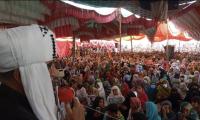There has been a contested debate over the viability and consistency of policies adopted and actions taken by developing countries to attain the Millennium Development Goals (MDGs).
At the end of the year 2015, there were optimistic claims that most of the developing countries had attained the international development goals envisaged in the MDGs. Around 191 UN member states and some 13 international development organizations committed to uphold the MDGs as their development agenda. These MDGs ranged from halving extreme poverty to reducing the spread of HIV/AIDs by 50 percent to ensuring universal primary education till the year 2015. MDGs were adopted in the Millennium Summit of the United Nations in 2000 with the primary objective to help the Global South meet its development targets in 15 years.
The achievement of the MDGs was predominantly measured in terms of the ability of a developing country to reduce extreme poverty by 50 percent. However, the remaining seven goals – important as they were – could not trigger much contested debate other than a simplistic mention of figurative national gains. Even the debate around eradicating extreme poverty became subsumed in a neoliberal development discourse of economic transition. The economic transition from indigenous and protectionist productive processes to a liberal growth-oriented model was seen as a way to eradicate extreme poverty.
Some developing countries like India and Brazil became oft-repeated references in defence of transitioning to neoliberal vertical growth to reduce poverty. Vertical growth resulted in a rapid expansion of GDP and hence a healthy income per capita count. This income per capita count was a simple math of dividing the total GDP against the population, showing a hypothetical increase in individual incomes.
However, the vertical growth of economies led to extreme forms of disparity without addressing the fundamental issue of poverty. For instance, while India was growing under a neoliberal economic order, farmers in rural India started to experience unprecedented poverty and privation. While on a fast-track of vertical growth of metropolitan India, the real India of the rural poor lost its way – resulting in the rapid increase of suicides amongst the over-indebted poor farmers.
It is interesting to see that the period of fastest growth of the Indian economy was also the era of increased disparity. The claims of poverty reduction through vertical growth proved to be short-lived in a neoliberal India where the widening income disparity among the urban rich and peri-urban and rural poor deteriorated the political and cultural fabric. The nouveau riche professional elite, corporate managers and metropolitan middle classes came forward to defend neoliberalism against the rising tide of resistance from rural India. The Indian middle class even went to the extent of defending the Hindu fascism of Narendra Modi as a symbol of political and economic stability in India.
The seeds of the current fascism in India were sown much earlier when the Indian opulent middle class, private media and corporates started to use saffron insignias of Hindutva as a brand of shining India. India’s constant vertical growth has exacerbated the status of the extreme poor. In Brazil, with a sporadic tilt towards neoliberal ideals, the path of economic growth was less consistent than India’s – with less visible signs of income disparity between the rich and poor as compared to India as well.
Pakistan also opted for a neoliberal economic model with the highest vertical growth in the first five years of Musharraf regime as a continuation of the previous civilian regime of the PML-N. The Indian bubble has started to bust today but Pakistan faced it much earlier in 2007-08 and then gained growth momentum in 2014 again.
In India, Brazil and Pakistan the poverty reduction policies proved to be short-lived. Countries like China, on the contrary, which did not follow the path of neoliberal economic growth, performed much better in terms of reducing poverty substantially without producing much income disparities between the rich and the poor.
With the lessons learnt from MDGs vis-a-vis consistency and sustainability in attaining the goals, it was realized that there was a need to propound upon a more comprehensive framework of international development goals. A new framework was formulated to address the multidimensionality, spatiality and interconnectedness of the development challenges in the era of globalization. During the last two decades, the world has seen the rise of the South in the Global North and the North in the Global South. It was no more only about the developing world or the Global South which mattered exclusively as the only domain of international development goals. The focus shifted to an inclusive global agenda of development in the face of rising disparity across the globe.
It was this new realization of the changed global reality of economic marginalization, disparity, political infringement and social exclusion that led to the formulation of Sustainable Development Goals (SDGs). The SDGs provided a larger development spectrum which was more integrated and better aligned with the globalization of disparities and poverty than the MDGs.
All 17 goals of the SDGs are interlinked, and they represent the universal principles of development. These universal principles of development include ending poverty and hunger, ensuring quality basic services to all, gender equality, climate action, and affordable energy and clean water and partnerships for prosperity etc. SDGs are, therefore, not only about the geographically defined development challenges of the Global South but also resonate well with the rising issues of disparity and disillusionment in the Global North.
In 2015, the government of Pakistan claimed that it was able to reduce extreme poverty in line with its MDG commitment but that claim proved to be short-lived. The economy saw a sharp downturn again in 2018 – three years after the launch of SDGs. In 2018-19, poverty increased by eight percent, exacerbated further with the onset of Covid-19. Poverty in Pakistan has increased from 32 percent in 2017 to 43 percent in 2021.
This is also true for many other countries in the developing world which followed a neoliberal growth model that eventually led to the creation of bubble economies. The poverty reduction achievements under the MDGs were only econometric counts with little impact on long-term and intergenerational poverty. Based on the lessons learnt from MDG commitments, it is important that policymakers take the responsibility of working for long-term policies to meet the SDGs’ commitments. The establishment of an SDG secretariat and formation of the SDG taskforce of parliamentarians is a good step towards creating ownership regarding the SDG targets among legislators.
The current decade has already been declared by the UN as the decade of action on SDGs and it is hoped that we start thinking of long-term pro-poor development initiatives. In some of the forthcoming articles I will focus on the role and achievements of the SDG secretariat.
The writer is a social development and policy adviser, and a freelance columnist based in Islamabad.
Email: ahnihal@yahoo.com
Twitter: @AmirHussain76
This demand has fueled rapid growth deposit base of Islamic Banks and Islamic Windows operated by conventional banks
But Punjab Agriculture Food and Drug Authority building near Thokar Niazbeg on Multan Road stands out
Macron has been particularly vocal in their criticism, asserting that withholding arms from Kyiv plays directly into...
As PPP governs province, Bilawal Bhutto Zardari holds strategic position to address both violence and its underlying...
Critics argue that strategy is vague, but closer look indicates strategic alignment with global trends and national...
To defeat it, we must distrust bot-driven narratives, to defeat it, we must verify sources before believing or sharing







